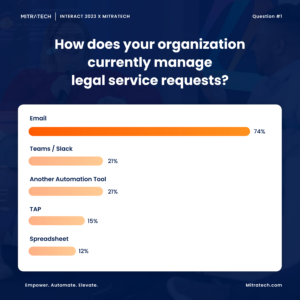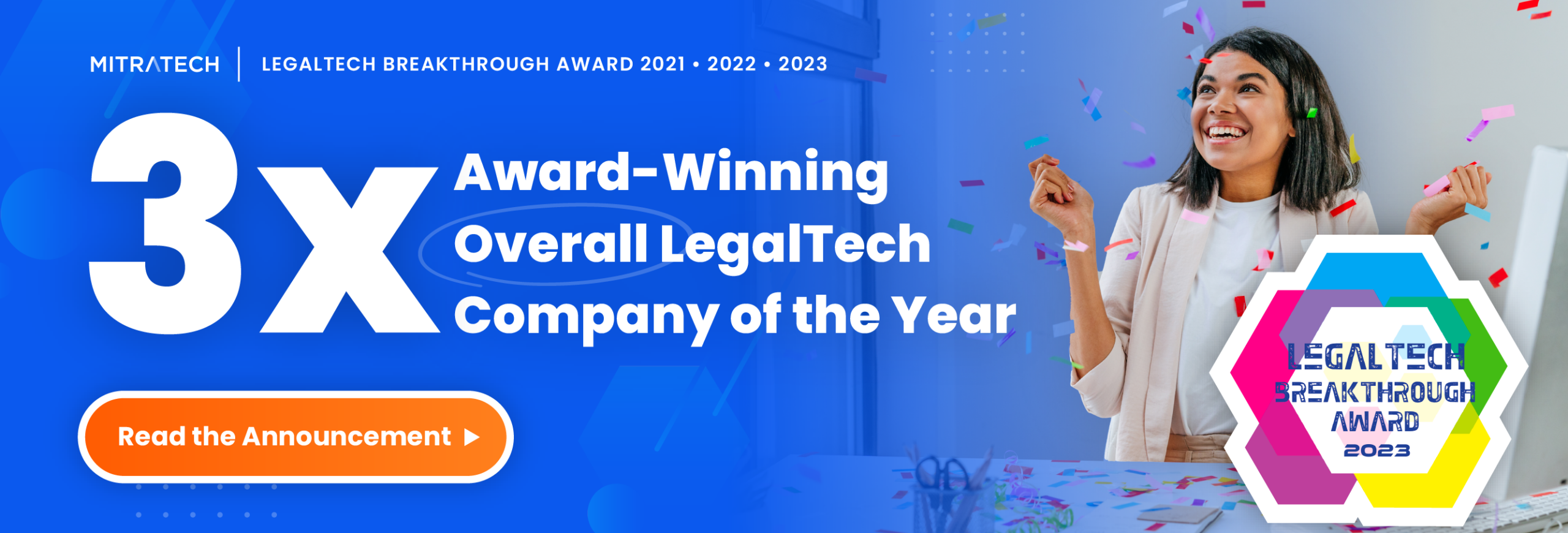Tech the halls: 4 legal tech insights for 2024, unwrapped.
We’re bidding farewell to another transformative year in legal tech (and here at Mitratech!). Meanwhile, there’s lots to look forward to in 2024.
To commemorate and celebrate, let’s take a walk down memory lane with a look at some of the most significant industry topics and concerns we covered this year — as well as some of Mitratech’s own notable legal tech innovations that address them.
[P.S. Some of these new partnerships, product enhancements, and roadmap additions for Mitratech in 2023 helped earn us the title of “Overall LegalTech Company of the Year” by the 4th annual LegalTech Breakthrough Awards program – for the third year in a row. But we’ll cover that. First, let’s dive into some top legal tech insights for 2024.]
 Self-service is in. Bottlenecks are out.
Self-service is in. Bottlenecks are out.
Every day, the average office worker receives an average of 120 emails. Legal professionals likely receive even more.
To that end, a poll at Mitratech’s Annual User Conference, Interact 2023, revealed that 74% of the audience relies on email as their main approach to managing legal service requests.
 Interact 2023 audience poll | Mitratech’s Annual User Conference
Interact 2023 audience poll | Mitratech’s Annual User Conference
It’s hard to keep up with all of these emails and even harder to manage efficient turn-around times that move according to SLAs — all while maintaining compliance with your company’s larger information governance goals. Thankfully, a “legal front door” can help automate, streamline, and elevate your legal operations, reducing the need to rely on memory and email.
A legal front door is a self-service request portal that welcomes users who need to interface with legal. Instead of emailing the department with a frequently-asked question or request for a generic contract, employees can drop into the portal to access whatever they need with minimal touchpoints. For example, they can request an NDA or contract, and by filling out select fields, their request can either send them an automated template or get escalated automatically if the request is more complicated.
From enabling self-service to freeing up more time for team members (which 74% and 66% of attendees ranked as their most desired outcome when implementing a legal front door, respectively), there are a multitude of reasons why today’s legal teams are turning to workflow to enhance productivity and self-sufficiency in 2024.
 Integration: the key to efficiency
Integration: the key to efficiency
Speaking of productivity, the phrase “do more with less” may be overused, but it’s still relevant. General Counsel expect workloads to increase by 25% over the next three years, yet 75% don’t expect budgets to keep pace.
That means that teams will need to double down on streamlining high-touch processes, optimizing their focus hours, minimizing disruptions, and collaborating with other departments more effectively. But in today’s fast-paced world, efficiency drains are everywhere. A recent HBR study discovered that individuals involved in executing a single supply-chain transaction switched between 22 different applications or unique websites a staggering 350 times. On an average day, employees find themselves toggling between applications and windows over 3,600 times.
We call this context switching — as companies work to elevate their efficiency with an influx of “productivity apps,” the opposite is taking effect: technology bloat, application overwhelm, and productivity-related challenges stemming from too much toggling. So, in addition to keeping teams informed on the perils and best practices for avoiding toggle anxiety in the digital era, we’re also working on ways to mitigate it into our product roadmaps.
Mitratech’s no-code workflow automation platform, TAP, also recently released the TAP Microsoft Teams App, enabling workflow management, collaboration, and visibility directly in the Teams App enterprise-wide. By eliminating the need to jump between email, TAP, and third-party platforms to check the status of or take action on in-progress workflows, this first-ever integration offers teams a way to mitigate toggle anxiety and elevate efficiency.
 Risk is a team sport that’s rising in popularity
Risk is a team sport that’s rising in popularity
According to Gartner, at least 50% of C-level executives will have performance requirements related to cybersecurity risk built into their employment contracts by 2026. This comes as no surprise when you consider the current threatscape.
A study conducted by the University of Maryland found that a threat actor targets a business’s cybersecurity infrastructure every 39 seconds on average. In response, regulatory bodies are tightening their grip (like the US’ SEC regulations, EU’s GDPR, or the UK’s DPA, to name a few) necessitating a proactive and transparent approach to IT risk management and regulatory compliance that spans the entire organization.
Meanwhile, your board is also poised to become more involved than ever in understanding and overseeing your risk technology, reporting, ethics, and disclosure — and they’re going to start asking more questions. Equip yourself with the knowledge and tools needed to confidently support the risk professionals in your organization, address your stakeholders’ inquiries, and stay one step ahead in the ever-changing realm of IT risk oversight.
[P.S. From intaking and evaluating third-party vendors to providing a platform (and dashboard) for inter- and cross-departmental assessments, workflow automation can help fortify the foundation of your risk and compliance strategy. See how.]
 Legal holds don’t have to feel like a hold-up
Legal holds don’t have to feel like a hold-up
Delivering the legal hold notice is the first step toward making sure that your employees understand that all related data and files (whether stored on paper or electronically) can neither be altered nor deleted when your company faces litigation, a government investigation, or an audit.
When data is deleted that would otherwise be relevant to a litigation case, your company could face serious legal, financial, and reputational damages. In the case Knickerbocker et al. vs. Corinthian Colleges, for example, the Colleges were penalized $25,000, and their legal counsel had to pay an additional $10,000.
In this sense, an effective hold process is a bit like insurance — always worth the investment (and not having it could be costly). But from procedural nuances to technological advancements, the process and scrutiny surrounding it has evolved. We’ve gathered up our top expert tips from this quarter on the creation, communication, and management of legal holds in two eBooks:




